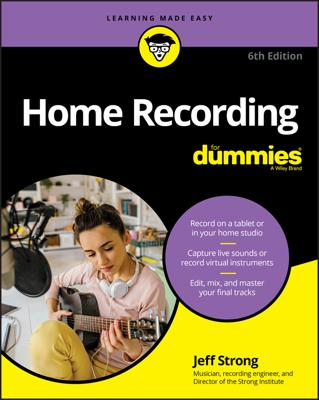Because music compressors are used and abused so frequently in home recording, it might be helpful for you to have some basic settings for stringed instruments to get you started. This will hopefully save you the headache of ruining a few tracks before you get the hang of this powerful tool.
Electric guitar
Generally, electric guitar sounds are pretty compressed. You don’t need additional compression when you track the guitar unless you use a clean (undistorted) setting on your guitar. If you want to use a little compression to bring the guitar forward and give it some punch, try these settings:
Threshold: –1dB
Ratio: 2:1–3:1
Attack: 25–30 ms
Release: About 200 ms
Gain: Adjust so that the output level matches the input level. You don’t need much added gain.
The slow attack is what gives the guitar a bit of punch. If you want less punchiness, just shorten the attack slightly. Be careful though, because if you shorten it too much, you end up with a mushy sound. (Sorry . . . ahem . . . the guitar has no definition.)
Electric bass
Another way to get a handle on the potential muddiness of the amplified bass guitar is to use a little compression. Compression can also help control uneven levels that result from overzealous or inexperienced bass players. Try these settings for a start:
Threshold: –4dB
Ratio: 2.5:1–3:1
Attack: 40–50 ms
Release: About 180 ms
Gain: Adjust so that the output level matches the input level. You don’t need much added gain.
When using compression on bass, make sure that your attack setting isn’t too short or the sound becomes muddy.
Strummed or picked acoustic stringed instruments
You don’t generally need a lot of compression on acoustic stringed instruments, especially if you want a natural sound. You can use the compressor to even out the resonance of the instrument to keep the main character of the instrument from getting lost in a mix and to avoid a muddy sound. These are good settings for strummed or picked acoustic instruments:
Threshold: –6dB
Ratio: 3:1–4:1
Attack: Around 150 ms
Release: About 400 ms
Gain: Adjust so that the output level matches the input level. You don’t need much added gain.
The release is set very high because of the amount of sustain that these acoustic instruments can have. If you play an instrument with less sustain, like a banjo, you may find that a shorter attack and release work just fine. In this case, try the following settings:
Threshold: –6dB
Ratio: 2.5:1–3:1
Attack: 40–50 ms
Release: About 180 ms
Gain: Adjust so that the output level matches the input level. You don’t need much, if any, added gain.
Classical strings
For the most part, adding compression to string instruments played with a bow isn’t necessary. However, you will find that using a compressor on a plucked acoustic bass and fiddle can bring them out in a mix.
A starting point for compressor settings for a fiddle would be as follows:
Threshold: –4dB
Ratio: 2:1–3:1
Attack: 40–50 ms
Release: About 100 ms
Gain: Adjust so that the output level matches the input level. You don’t need much, if any, added gain.
Try these settings for the acoustic bass:
Threshold: –6dB
Ratio: 5:1–8:1
Attack: 40–50 ms
Release: About 200 ms
Gain: Adjust so that the output level matches the input level. You need a bit of added gain here.

